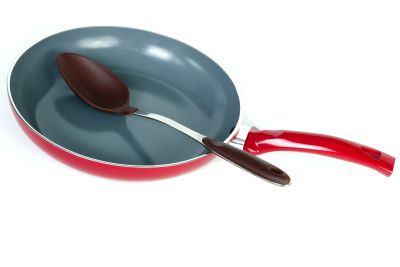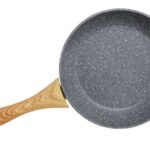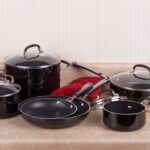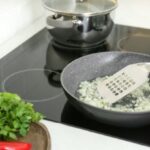Types of Ceramic Cookware
Recently, nonstick ceramic cookware has become one of the most popular types of cookware on the market. It is promoted as a safe alternative to Teflon. The ceramic coating provides the benefits of a nonstick cooking surface without the dangers of PFOA, a potentially toxic chemical used in the production of a traditional nonstick coating.
There are two different types of ceramic cookware: Pure ceramic cookware and cookware with a ceramic coating. They are made of different materials and differ significantly in performance.
A lack of labeling requirements can confuse shoppers thinking about purchasing modern nonstick cookware. To make an informed purchase, potential buyers need to take some time to learn about the differences between the new type of “ceramic” cookware and classic ceramic cookware.

1. Pure Ceramic Cookware
100% ceramic cookware is made from clay, minerals, and quartz sand. After the shaping process, the mixture is hardened by firing to vitrification at 1915 degrees Fahrenheit. Ceramic cookware is glazed to get a decorative and waterproof finish.
Clay ceramic cookware is also called pure or classic ceramic cookware. The most reputable brands of pure ceramic cookware are Xtrema and Emile Henry.
2. Ceramic-coated Pots and Pans
Ceramic-coated cookware has a metal base, such as aluminum. The base is coated with a hard film of polymer materials with a ceramic look. This coating contains binders, non-stick components, color pigments, and reinforcing agents.
This non-stick coating is not permanent and will wear over time even with normal use, resulting in the metal base being exposed. Depending on care and frequency of use, this cookware is functional for 3 to 5 years.
This ceramic-coated cookware is often called ceramic non-stick cookware or modern ceramic cookware.
Differences Between 100% Ceramic and Ceramic Coated Cookware
1. Ergonomics
With 100% ceramic cookware, the cooking surface and handle are made in one piece. The vessels can be heavy and difficult to handle, especially when hot. Innovative pure ceramic cookware is made from a lightweight ceramic material and may have removable silicone handles.
Ceramic-coated cookware features an ergonomically designed, heat-resistant handle attached to the pot with rivets. This cookware is much lighter and easier to handle than 100% ceramic pots and pans due to the lightweight aluminum core.
2. Microwave Heating
100% ceramic cookware can be used in the microwave, while ceramic-coated cookware cannot be microwaved due to its metal base.
3. Heat Retention
Pure ceramic cookware retains heat in its thick ceramic walls, keeping meals hot long after the stove is turned off. Ceramic-coated cookware no longer retains heat when the heat source is turned down.
4. Utensils
Metal utensils will not damage pure ceramic pots and pans. However, certain brands of ceramic cookware such as Xtrema recommend using wood, bamboo, or silicone utensils because metal utensils can leave metal particles on the hard ceramic surface or leach metals when cooking.
Metal utensils are generally not recommended for nonstick ceramic cookware because metal can scratch the soft internal ceramic coating and cause faster wear.
5. Oven Use
Traditional ceramic bakeware is perfect for baking foods in the oven. Pure ceramic cookware can handle oven temperatures of up to 2000 ° F, so you can use it in any oven.
Older and less expensive brands of ceramic-coated cookware can be used in an oven only up to 450 F°. However, the newest brands of ceramic-coated cookware such as Skanpan can withstand oven temperatures up to 850 F°. This cookware has a reinforced interior coating and stainless steel handles.
6. Induction Compatibility
Modern ceramic-coated cookware is made of stainless steel with an aluminum core to ensure maximum heat distribution (aluminum) and compatibility with induction cookers (stainless steel). Pure ceramic cookware is not compatible with induction cookers. To use it on an induction stove, you need an induction plate.
7. Washing
Pure ceramic cookware has a glass-like surface that is impermeable to liquids and is dishwasher safe.
Ceramic-coated cookware should be washed by hand because dishwasher detergents can damage the nonstick surface.
8. Safety
After being dipped in a glaze, pure ceramic cookware must be kiln-fired long enough to undergo a process called vitrification. This process makes the surface impermeable to water. After proper glazing, the surface is considered safe for food contact. 100% ceramic cookware from well-known manufacturers consists of properly tested and fired clay. Such cookware is non-reactive and is safe for food preparation.
Modern nonstick cookware is manufactured using new technologies, such as nanotechnology, which has not been proven to be completely safe. More research should be conducted to study the effects of nanoparticles on human health and the environment.





Between the two type of Ceramic Cookware, I like Pure Ceramic Cookware. Because the facility of pure ceramic ceramic cookware is greater than the Ceramic Coated Cookware.
Thank You for providing us with pure facts and truth! You’re blog is the only one that I’ve read where you not only explain the difference between “Pure Ceramic” Cookware and “Ceramic Coated” Cookware, but you even listed 100% Pure Ceramic Cookware companies. The other blogs listed companies who uses aluminum and other metals with a ceramic coating as pure ceramic cookware. Of course, these blogs all give their affiliate links for people to purchase these fake all ceramic cookwares. To anyone reading this, please stay away from those other blogs who lie to you and stick with this blog who gives you the Pure Ceramic Cookware Truth!
I can’t find 100% ceramic pans, I am looking for a safe non stick pan and seems the only option is ceramic coating.
Xtrema Ceramic pans are not currently available on Amazon.com, but you can find them if you search online.
Same issue on Amazon, but you can go to Xtrema.com. It is rather pricey. Looking for the same quality, but better value. FYI, Xtrema IS manufactured in China where there are loose rules about what can be included in the coatings and materials. We are looking for a 100% Ceramic option made here and no leaching to avoid heavy metals and toxins. Any suggestions to the real deal are welcomed!